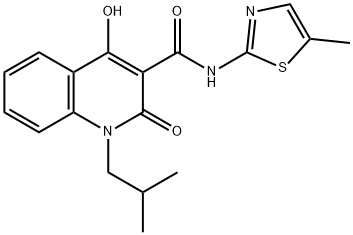Definition
ChEBI: 4-hydroxy-1-isobutyl-N-(5-methyl-1,3-thiazol-2-yl)-2-oxoquinoline-3-carboxamide is a member of the class of quinolones that is the amide obtained from formal condensation of the carboxy group of 4-hydroxy-1-(2-methylpropyl)-2-oxo-1,2-dihydroquinoline-3-carboxylic acid with the amino group of 5-methyl-1,3-thiazol-2-amine. It is a monocarboxylic acid amide, a member of 1,3-thiazoles, a quinolone and a monohydroxyquinoline.
General Description
A cell-permeable 4-hydroxy-2-oxo quinoline carboxamide that acts as an agonist of AMPK signaling. It is shown to reduce fat storage in
C. elegans (EC
50 ~ 0.1 μM) and reduce the expression level of fat-7 (a
C. elegans ortholog of mammalian stearoyl-CoA desaturase-1), through aak-1 (an ortholog for the AMPK-α1 catalytic subunit) and K08F8.2 (a transcription factor) dependent mechanisms. In addition, it markedly reduces the number of lipid droplets in HepG2 human hepatocarcinoma cells at 25 μM, and elicits the phosphorylation and inactivation of acetyl coenzyme A carboxylase (ACC, the enzyme that catalyzes the rate-limiting step in
de novo fatty acid synthesis). F17-induced ACC phosphorylation can be abrogated by simultaneous treatment with an AMPK inhibitor compound C (Cat. No.
171260).
